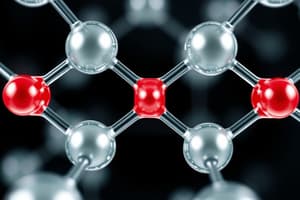Podcast
Questions and Answers
What is the main characteristic of a molecular compound?
What is the main characteristic of a molecular compound?
- Composed of two different metal elements
- Good conductor of electricity and heat
- Gaseous or liquid at room temperature (correct)
- High melting point compared to ionic compounds
What type of bonding exists in a molecular compound?
What type of bonding exists in a molecular compound?
- Hydrogen bonding
- Ionic bonding
- Covalent bonding (correct)
- Metallic bonding
How are the valence electrons represented in Lewis dot structure?
How are the valence electrons represented in Lewis dot structure?
- As dots (correct)
- As circles
- As lines
- As dashes
What is the composition of a diatomic molecule?
What is the composition of a diatomic molecule?
Why do molecular compounds have low melting points compared to ionic compounds?
Why do molecular compounds have low melting points compared to ionic compounds?
Which type of bond is formed when two atoms share three electrons?
Which type of bond is formed when two atoms share three electrons?
In the structural formula of molecular compounds, where is the element with the highest number of unpaired electrons and highest electronegativity placed?
In the structural formula of molecular compounds, where is the element with the highest number of unpaired electrons and highest electronegativity placed?
What is a coordinate covalent bond?
What is a coordinate covalent bond?
What do resonance structures occur for?
What do resonance structures occur for?
What is the difference between atomic orbitals and molecular orbitals?
What is the difference between atomic orbitals and molecular orbitals?
What is the difference between a single covalent bond and a double covalent bond?
What is the difference between a single covalent bond and a double covalent bond?
Explain the concept of a coordinate covalent bond with an example.
Explain the concept of a coordinate covalent bond with an example.
What are resonance structures and when do they occur?
What are resonance structures and when do they occur?
Explain the difference between atomic orbitals and molecular orbitals.
Explain the difference between atomic orbitals and molecular orbitals.
In the Lewis dot structure of methane (CH4), why is carbon placed in the center and how does it share electrons with hydrogen?
In the Lewis dot structure of methane (CH4), why is carbon placed in the center and how does it share electrons with hydrogen?
What is the key characteristic of a diatomic molecule?
What is the key characteristic of a diatomic molecule?
How does the melting point of a molecular compound compare to that of an ionic compound?
How does the melting point of a molecular compound compare to that of an ionic compound?
What type of elements make up a molecular compound?
What type of elements make up a molecular compound?
How are valence electrons represented in a Lewis dot structure?
How are valence electrons represented in a Lewis dot structure?
What does a structural formula of a molecular compound represent?
What does a structural formula of a molecular compound represent?
Flashcards are hidden until you start studying




